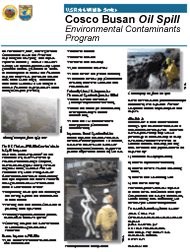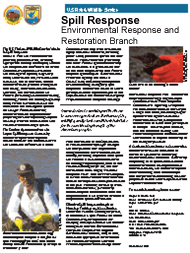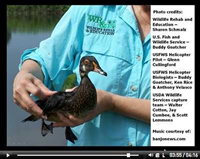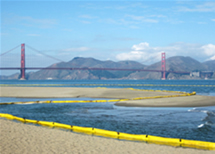|
|
Oil Spill Preparation and Response
The challenge of managing oil spills in the United States
is increasing in complexity and magnitude. Oil spills threaten
millions of miles of coastline, river systems, lakes and terrestrial
habitat daily, particularly where there is extensive oil drilling,
refining, and transport. Serious, and potentially permanent,
ecological damage is possible where chronic spills or spills
of national significance occur. The goal of the U.S. Fish
and Wildlife Service's Oil Spill Program is to emphasize early
(contingency) planning and cooperation at the local, regional
and national level in an effort to minimize the injury to
fish, wildlife, and sensitive environments from oil spills.The Departments of the Interior, Commerce and Agriculture,
together with Tribal governments, States, and other jurisdictions,
are responsible for protecting these natural resources. Because
oil spills respect no boundaries, uniform Federal policies
and programs are essential. In addition, since the resources
necessary to respond to oil spills are limited and vary among
the response agencies, it is more important than ever to establish
and strengthen cooperative relationships.
Some additional information published on the Oil Spill Program
include: Oil
and Nature (pdf), Oil Spills
and the Public (pdf), The
Service at Coastal Oil Spills (pdf).
Recent Spills of National Interest:
New Orleans, Louisiana Oil Spill (Tanker Tintomara Collision with Barge DM932) Response Site |
|
On July 23, 2008, a major release of #6 fuel oil occurred in the Mississippi River, in New Orleans, Louisiana. More than 9,000 barrels of oil were released. The release necessitated the closure of more than 80 miles of river to commercial shipping and recreational boating. The river, shorelines, and adjacent wetlands were impacted in much of the area. This incident represents a significant threat to fish, wildlife, and habitat quality. U.S. Fish and Wildlife Service Environmental Contaminants Program and National Wildlife Refuge System personnel have responded to the incident.
More Information (Update for August 17, 2008)
New Orleans, Louisiana Oil Spill Wildlife Rescue Video. (USFWS Video. Added September 8, 2008)
U S Fish and Wildlife Responds to Oil Spill (Video produced by Paradise Louisiana cable television show - July 31)
Efforts to protect wildlife in high gear after oil spill. (Service staff were interviewed for this piece) WWLTV (Louisiana) Eyewitness News story - July 29.
National Public Radio Interview of Steven Alexander, of the U.S. Fish and Wildlife Service |
| |
Cosco Busan, San Francisco, California: |
|
 |
| San Francisco - Oil booms line a San Francisco, California, beach. November 9, 2007. The beach was closed after oil spilled fram a South Korea-bound container ship after it struck a tower supporting the San Francsico-Oakland Bay Bridge in dense fog. Credit: Desmond Thorsson/U.S. Coast Guard Auxillary. |
On November 7, 2007 the cargo vessel Cosco Busan hit the San Francisco Bay Bridge in heavy fog. The impact ruptured the hull (~100 ft x 12 ft and 4 ft deep) and spilled approximately 58,000 gallons of medium grade fuel oil. Most of the oil has spread to central San Francisco Bay and outer coast (North and South of the Golden Gate Bridge). The spill is did not make contact with San Francisco Bay National Wildlife Refuge Complex (NWRC) lands in the South Bay or offshore at the Farallon Islands, although oiled birds were found at all of the refuges.
Staff from the Sacramento Fish and Wildlife Office, San Francisco Bay National Wildlife Refuge Complex, California-Nevada Operations Office, Portland Regional Office, San Francisco Bay National Wildlife Refuge Complex, and Burlingame Law Enforcement Office assisted with spill response and natural resource damage assessment at various times.
As of 5 p.m. Dec. 6, 2007, information about the clean-up was as follows:
- Total personnel employed: 440
- Total gallons discharged: Approximately 58,000
- Total birds captured: 1,063
- Total birds cleaned: 783
- Total birds released: 347
- Total birds died in facility: 618
- Total birds dead on arrival: 1,759
- Remaining feet of boom laid out: 1,800
- Federally-listed endangered or threatened species injured or killed include:
The Cosco Busan incident is similar to a spill that occurred 11 years ago. On October 28, 1996, the Cape Mohican spilled approximately 40,000 gallons of Intermediate Fuel Oil very near the site of the current spill. According to Service employees who responded during both spills, the “behavior” of the Cosco Busan spill is very similar to the previous spill which has helped Contaminants and Refuge staff in planning their response and assessment actions.
Fact Sheets:
Cosco Busan Oil Spill (2MB pdf)
Spill Response - Environmental Response and
Restoration Branch (1MB pdf)
Oil Spills and the Public (pdf)
Oil and Nature (pdf)
The Service at Coastal Oil Spills (pdf)
Images From the Spill
USCG Oil Spill Slide Show
Cosco Busan Unified Command Oil Spill Response Site provides a list of closed beaches as well as beaches where the public can assist in cleanup efforts without hazardous material training.
California Department of Fish and Game - Spills and Events: COSCO BUSAN Spill
National Park Service, Golden Gate National Park - Oil Spill in San Francisco Bay
U.S. Coast Guard - Effects of Oil on Wildlife Resources |
| |
Links:The National Response Center (Federal contact for reporting
oil and chemical spills) - http://www.nrc.uscg.mil/nrchp.html
Department of the Interior, Office of Environmental Policy
and Compliance, DOI Emergency Preparedness and Response Strategy:
Oil Discharges and Hazardous Substances Releases - http://www.doi.gov/oepc/emerprep.html
Exxon Valdez Oil Spill Restoration Web Site
http://www.dnr.state.ak.us/commis/evos.htm
Exxon Valdez Oil Spill Restoration Plan
http://www.evostc.state.ak.us/Policies/restplan.cfm
North Cape (Rhode Island) Oil Spill Restoration - http://www.fws.gov/contaminants/restorationplans/NorthCape/NorthCape.cfm
The Tenyo Maru Oil Spill Natural Resource Trustees
Tenyo
Maru oil spill Restoration Plan
U.S. Coast Guard: Marine Safety and Environmental Protection
Response Information - http://www.uscg.mil/hq/g-m/nmc/response/index.htm
Environmental Protection Agency: Oil Spill Program - http://www.epa.gov/oilspill/
National Response Team: Ensuring Effective National Oil and
Hazardous Substance Preparedness and Response - http://www.nrt.org/
National Oceanic and Atmospheric Administration: Office of
Response and Restoration - http://response.restoration.noaa.gov/index.html
National Oceanic and Atmospheric Administration: Damage Assessment
and Restoration Program
- Chalk
Point/Swanson Creek Oil Spill, Maryland
- Tenyo Maru
Oil Spill, Washington
- Apex Houston
Oil Spill, California
- Chevron
Pipeline Oil Spill, Hawaii
- Tesoro Oil
Spill, Hawaii
- Apex
Galveston Oil Spill, Texas
- North
Cape Oil Spill, Rhode Island
- M/V
Kuroshima Oil Spil Restoration Plan
|




